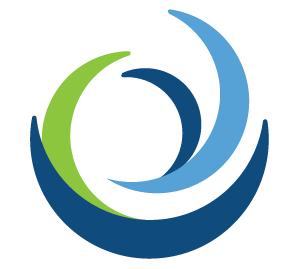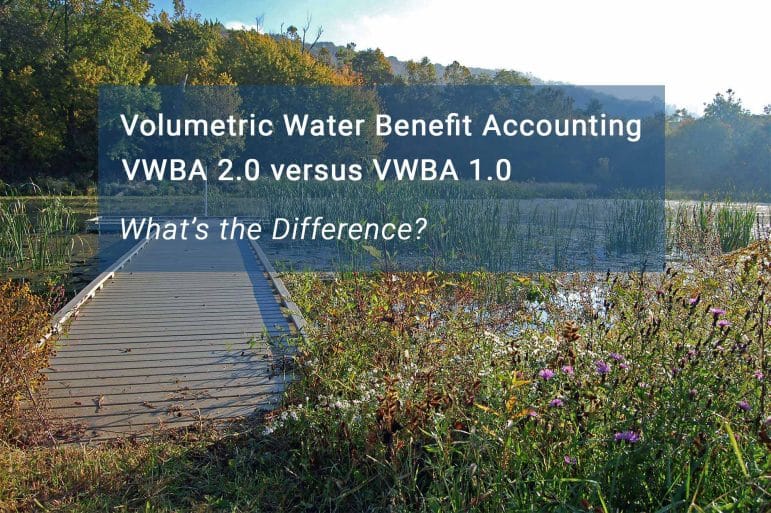
VWBA 2.0 versus VWBA 1.0 – What’s the Difference?
With the release of Volumetric Water Benefit Accounting (VWBA) 2.0, the water stewardship community may ask, “What’s new?” and “Will this new guidance change how we quantify and report water stewardship project benefits?” Read on for some answers and guidance.
By Laura Weintraub, Vice President and Water Stewardship Practice Area Lead, Penelope Moskus, Principal and Senior Environmental Scientist, and Pranesh Selvendiran, Senior Environmental Engineer (Ann Arbor, MI)
September 19, 2025
VWBA 2.0 expands upon the strong foundation established in VWBA 1.0 without fundamentally altering best practices and methods for quantifying volumetric water benefits (VWBs)
With the release of Volumetric Water Benefit Accounting (VWBA) 2.0, the water stewardship community may ask, “What’s new?” and “Will this new guidance change how we quantify and report water stewardship project benefits?” The short answer is VWBA 2.0 expands upon the strong foundation established in VWBA 1.0 without fundamentally altering best practices and methods for quantifying volumetric water benefits (VWBs).
- clearer articulation of programmatic guidance that has been followed as best practice for years,
- a more navigable structure through a step-by-step process, and
- refinement and expansion of some calculation methods.
Most importantly, the new guidance is a more complete and consistent “playbook” for water stewardship practitioners involved in funding, implementing, and quantifying volumetric water benefits.
Since its release in 2019, VWBA 1.0 has been widely adopted as a best-practice resource that provides comparable, credible, and transparent methods for quantifying the VWBs of water stewardship activities. As the complexity and scale of shared water challenges have intensified, there has been an increasing demand for expanded, standardized guidance on essential topics beyond quantification methods. VWBA 2.0 responds to this need by providing an enhanced version of guidance for corporate practitioners and project implementers with a clearly defined six-step method for identifying water stewardship activities and quantifying, tracking, and communicating their volumetric or water quality benefits.
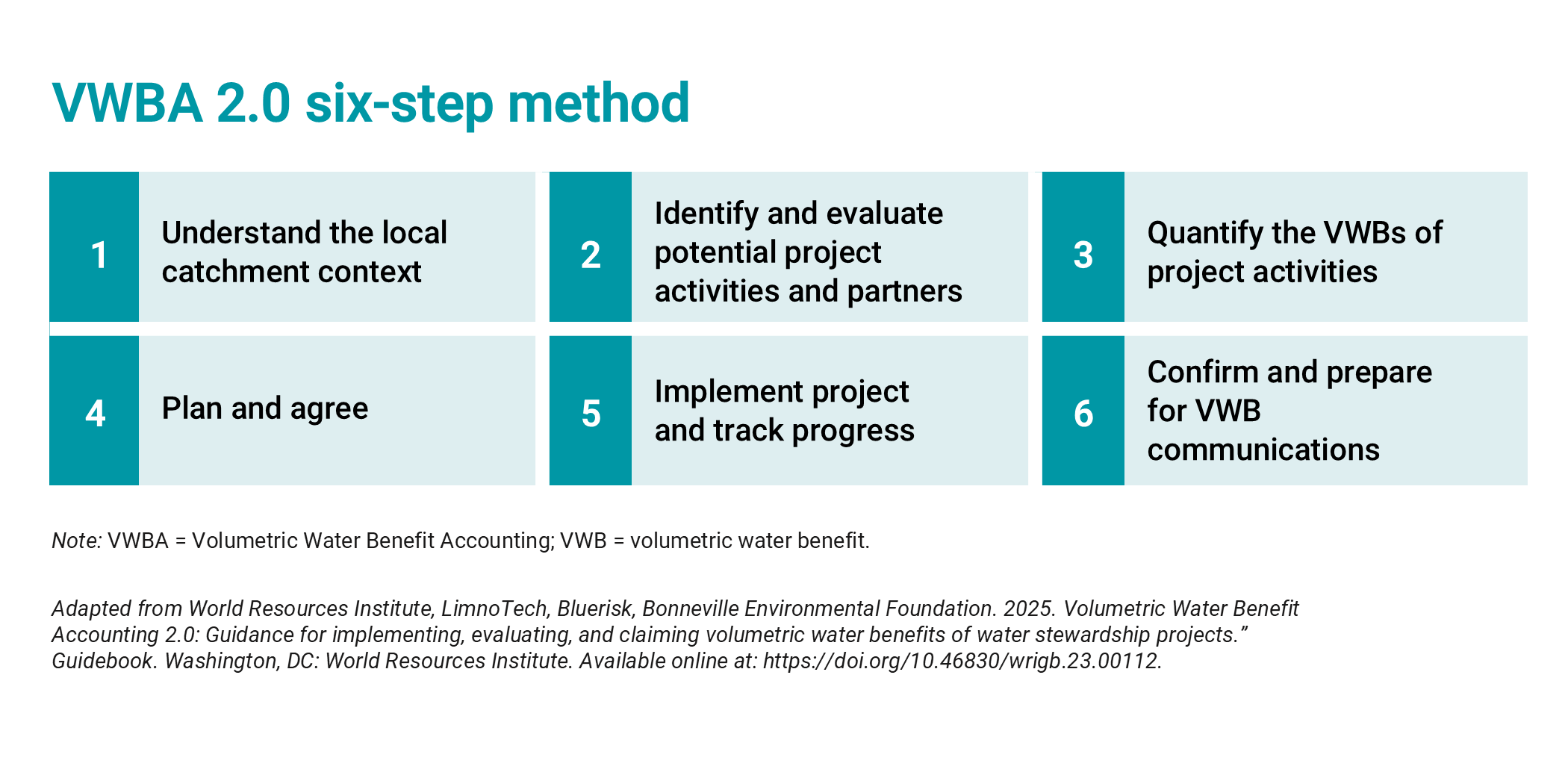
VWBA 2.0 is informed by decades of practitioner experience and industry best practices. Many of the high-level concepts in VWBA 1.0 have been refined into clear, specific guidance in VWBA 2.0. The updated VWBA 2.0 guidance remains principle-based and non-prescriptive, offering water stewardship practitioners and companies a consistent approach for making credible volumetric water benefit claims across diverse geographies and water stewardship activities.
The key differences between VWBA 2.0 and VWBA 1.0 are summarized in the following Table and additional highlights of these improvements are described below.
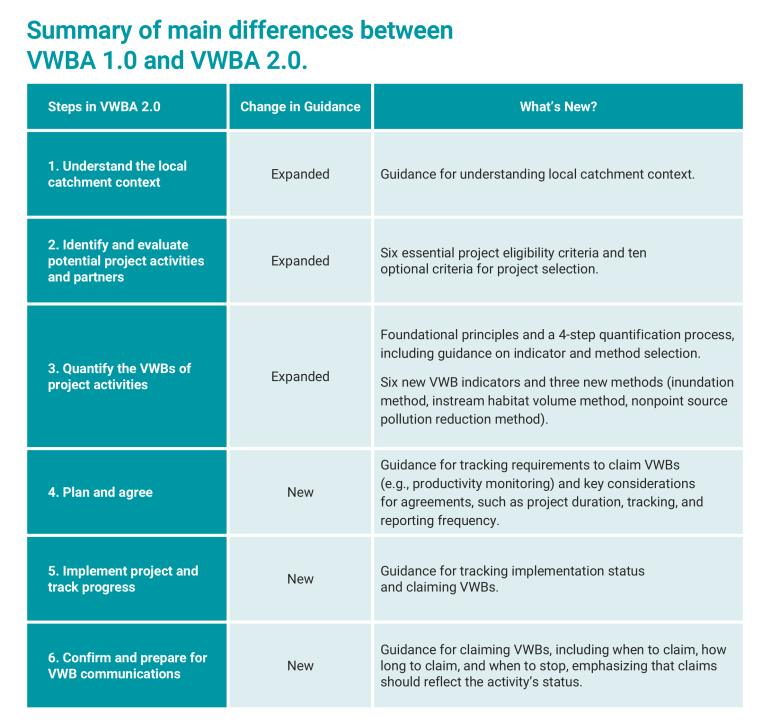
Project Eligibility and Selection
What makes a “good fit” water stewardship project with quantifiable VWBs?
VWBA 2.0 provides clear and updated guidance for the selection of effective water stewardship projects that have the potential to generate quantifiable VWBs. The guidance presents six eligibility criteria and ten selection considerations, along with a decision framework to inform project selection.
Project eligibility criteria define “must haves” for a project to potentially generate a quantifiable VWB. Project selection considerations are optional but can help practitioners identify, prioritize, and select projects. Companies can apply these criteria and considerations in their own decision-making process for water stewardship project selection.
The relative importance of individual criteria and considerations may vary based on a company’s exposure to risk, water goals, strategic watershed objectives, and project scale. Collectively, the eligibility criteria and selection considerations can guide practitioners in prioritizing and selecting projects that ensure the greatest likelihood of success, are most relevant to company goals, and potentially contribute to broader outcomes and impacts that extend beyond VWB outputs.
Project Tracking and Reporting
What tracking and reporting are needed for a credible project with VWBs?
VWBA 2.0 significantly strengthens the discussion of project tracking and reporting by providing structured guidance to develop a tracking and reporting plan to ensure that water stewardship projects are transparently documented, performance is tracked over time, and benefits are credibly communicated.
The steps for tracking and reporting include:
- Determine primary tracking and reporting requirements to claim VWBs.
- Determine if secondary tracking and reporting of other outputs beyond VWB is desired and achievable.
- Determine the necessary duration and frequency of project tracking and reporting.
- Work with project implementers to make a tracking and reporting plan.
Quantification of VWBs
How do I quantify VWBs for a water stewardship activity? Have the methods changed?
VWB quantification involves the calculation of a water benefit in terms of volume using appropriate indicators and methods. Credible quantification is essential for assessing progress towards a company’s water goals. VWBA 2.0 provides foundational principles and additional guidance for selecting VWB indicators and methods.
While most of the methods presented in Appendix D of VWBA 2.0 remain consistent with those in VWBA 1.0, several have been updated with added examples, and a few new methods have been introduced. Quantification can be implemented at the project planning phase (i.e., for preliminary VWB estimate) and/or after project implementation.
In support of VWB quantification, VWBA 2.0 provides:
- Foundational principles: These are basic rules to apply during VWB quantification They were developed by building on VWBA 1.0 and incorporating corporate water stewardship practitioner experience quantifying VWBs.
- Quantification steps: A 4-step quantification process helps practitioners select the appropriate VWB indicators and methods to address activity-specific objectives and assemble the required data for the quantification. These steps were developed recognizing that there is a wide range of potential activities that organizations may be interested in supporting and many ways that each of the methods can be applied.
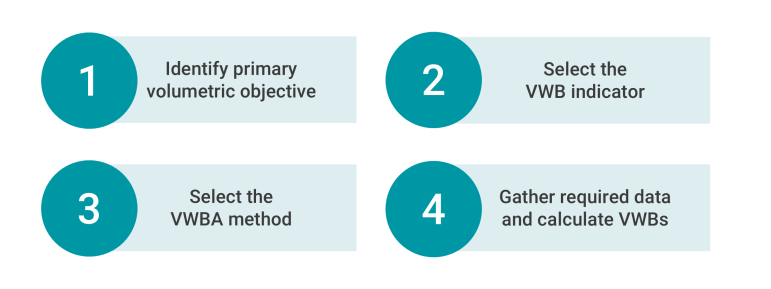
- Indicator and method selection: Clear guidance is provided to assist with identifying appropriate VWB indicators and methods based on the objective of the activities.
- New and revised indicators: Several new and revised VWB indicators and methods are included to estimate the volumetric water benefits of a wider range of activities than what was previously provided.
Communicating VWBs
How can I ensure that VWB communications and claims are credible?
VWB claims are any statements or communications about the delivery of existing or anticipated VWBs (typically expressed in liters, cubic meters, or gallons), resulting from voluntary water stewardship activities. Companies use VWB claims to demonstrate progress toward water-related goals. VWBA 2.0 contains specific guidance to assist companies with making credible VWB claims, while incentivizing water stewardship activities that address long-term shared water challenges.
Topics addressed include confirming project activity status, establishing attribution of VWBs among different entities, determining when to start claiming, and deciding how long the benefits can be claimed. Based on this guidance, companies can claim VWBs when project activities meet eligibility criteria, align with company goals, and have completed implementation with performance factors in place.
VWBs can be claimed for grey, green, or behavioral projects once they are delivering the intended hydrologic or practice changes, either fully or proportionally to their progress. Claims should continue as long as the activity is functioning, delivering impact, and the company remains actively involved through investment and support. Claims should stop if the company is no longer involved, the project is not functioning as designed, or its performance can’t be confirmed.
In Summary
VWBA 2.0 builds on VWBA 1.0 with improvements, including:
- Enhanced programmatic guidance following a 6-step process.
- Expanded technical guidance with foundational principles and updated quantification methods.
- New guidance for selecting the most appropriate VWB indicators.
The highlighted changes and improvements in VWBA 2.0 described above were developed with and informed by stakeholder engagement and decades of technical expertise. All improvements were integrated into a navigable six-step process that, when followed, enables practitioners to have confidence in the integrity of their water stewardship investments.
The project team (LimnoTech, WRI, Bluerisk, and BEF) welcomes water stewardship practitioners to view, use, and share VWBA 2.0 across their networks.
VWBA2.0 authors are LimnoTech (Penelope Moskus, Pranesh Selvendiran, Laura Weintraub, Wendy Larson), World Resources Institute (WRI) (Natasha Collins, Marc Dettmann, Todd Gartner, Sara Walker), Bluerisk (Paul Reig, Jenna Stewart), and Bonneville Environmental Foundation (BEF) (Sara Hoversten, Scott McCaulou, Todd Reeve, Robert Warren).
The VWBA 2.0 publication was made possible thanks to funding support provided by Amazon Web Services, Apple, Cargill, The Coca-Cola Company, Constellation Brands, Diageo, Ecolab, Google, Meta, Microsoft, Nestlé Waters, PepsiCo, Inc., Procter & Gamble, and Starbucks.
If you would like to learn more about how LimnoTech supports companies with their water stewardship goals and initiatives, don’t hesitate to get in touch with Laura Weintraub at lweintraub@limno.com, Penelope Moskus at pmoskus@limno.com, or Pranesh Selvendiran at pselvendiran@limno.com.
Follow us on LinkedIn and check the Insights & Perspectives page on our website for more information and updates.
Laura Weintraub, PE, is Vice President, Senior Environmental and Water Resources Engineer, who directs LimnoTech’s corporate water stewardship practice area. Laura has over 25 years of experience supporting public, private, and research clients in the areas of watershed planning, water sustainability, TMDLs, stormwater management, source water protection, and decision-support system development. She supports companies in tech, food and beverage, manufacturing, electric power, and agriculture sectors with water stewardship strategy and target setting; water stewardship program development and implementation; water accounting; context-based water risk assessments; replenish project scoping and benefit quantification; AWS training and certification; and sustainability reporting. Laura supported the development of several multi-benefit quantification methodologies: volumetric water benefit accounting (VWBA 2.0), water quality benefit accounting (WQBA), and biodiversity benefit accounting (BioBA). She provides technical support and leadership on two water collaboratives established to address the ambitions of the CEO Water Mandate’s Water Resilience Coalition to mobilize corporate water stewardship in 100 basins globally: California Water Resilience Initiative (CWRI) and Mississippi Basin Water Action Collaborative (MRWAC). Primary activities included basin goal and target setting, roadmap development, and project pipeline development.
Penelope Moskus is a Principal and Senior Environmental Scientist with 30 years of experience. Penelope co-directs LimnoTech’s corporate water stewardship practice area, helping clients develop strategies, guidance, and tools to reduce water-related risks and supporting clients with water stewardship program implementation. She advises clients on project selection, has evaluated volumetric and complementary benefits of hundreds of potential and funded projects, and annually supports corporate reporting for numerous companies. Penelope has supported a major corporation’s replenishment program for 15+ years, including strategy development; development of replenish guidance; quantification and reporting of replenish benefits; validation, verification, assurance, and advising on internal audits. She also supports global and local NGOs, food and beverage companies, energy providers, high-tech companies, agricultural providers, and supermarket chains. Penelope contributed to Volumetric Water Benefit Accounting (VWBA) and is one of the authors contributing to VWBA 2.0. She has piloted Water Quality Benefit Accounting (WQBA) and is a Professionally Credentialed Specialist Consultant for the AWS Standard.
Pranesh Selvendiran, PhD, is a Senior Environmental Engineer at LimnoTech. He has 17 years of technical and project management experience through a wide variety of projects in the U.S. and around the world. Pranesh supports LimnoTech’s corporate water stewardship practice area, helping clients assess and improve water management and develop strategies to minimize water quantity and quality impacts and risks. Pranesh’s principal areas of expertise include volumetric water benefit accounting (VWBA), water footprinting, operations and supply chain risk assessments, development and applications of water benefit methodologies, water strategy development, CDP water disclosure and reporting, development of watershed and hydrologic models, and project management. He has led and supported water risk assessments for several global companies and evaluated the water benefits of numerous water stewardship projects implemented worldwide by multiple multinational corporations. He is an accredited consultant for the AWS Water Stewardship Standard.


